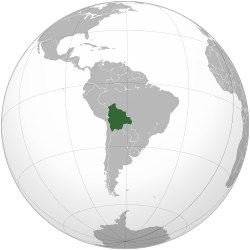This article needs to be updated.(August 2023) |
| 2010 Bolivia forest fires | |
|---|---|
 | |
| Date(s) | 15 August 2010 – present |
| Location | Bolivia |
| Statistics | |
| Land use | forest |
| Impacts | |
| Structures destroyed | 60 |

The 2010 Bolivia forest fires led the country's government to declare a state of emergency, as wildfires spread across the country. More than 25,000 fires are burning across 15,000 square kilometres (3,700,000 acres). These raging fires have destroyed nearly sixty homes. Bolivia is unable to combat the fires properly as it does not have enough water bombing aircraft. [1]
Contents
There was a steep jump in fire hot-spots from 17,000 on Sunday August 15 to approximately 25,000 three days later. [2] Some of the blazes were so strong that firefighters were unable to get close enough to contain them. [2] The head of Bolivia's forestry service, Weimar Becerra, described the fires as "a total disaster, it is an environmental disaster. We have six forest fires which have a height of 50 m and are growing, and as a country we do not have the capacity to put them out". [2]